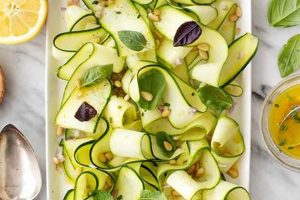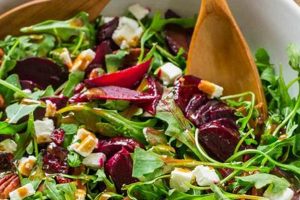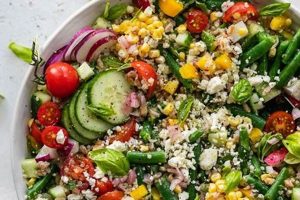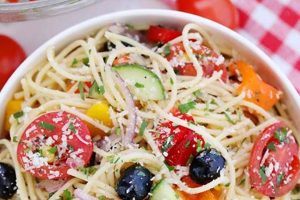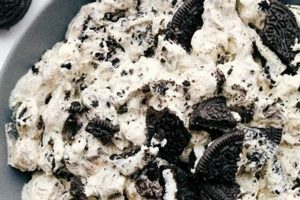A layered salad, typically refrigerated for a full day before serving, allows the flavors of the various components to meld and deepen. Common ingredients often include chopped vegetables like lettuce, tomatoes, onions, and peppers, along with cheeses, proteins such as ham or bacon, and a creamy dressing. Variations frequently feature pasta, eggs, or croutons.
The extended refrigeration period is key to this style of salad. It allows the dressing to soften crisp vegetables, creating a cohesive blend of textures and a more unified flavor profile. This approach to salad preparation was particularly popular in mid-20th century America, offering a convenient make-ahead dish for potlucks, picnics, and holiday gatherings. The practicality of preparing the salad a day in advance contributed significantly to its enduring appeal.
This article will further explore the historical context of these layered salads, provide several classic recipes, and offer modern adaptations for contemporary tastes. It will also delve into the science behind the flavor development that occurs during the 24-hour refrigeration period, and offer tips and techniques for achieving optimal results.
Tips for Layered Salads
Achieving optimal results with a layered salad requires attention to ingredient selection, layering technique, and proper refrigeration. The following tips offer guidance for creating a successful and flavorful dish.
Tip 1: Crisp Vegetables are Key: Choose vegetables with structural integrity, such as romaine lettuce, iceberg lettuce, or radicchio. Avoid delicate greens like spinach or butter lettuce, which may become soggy during the refrigeration period.
Tip 2: Layer Strategically: Place sturdier ingredients at the bottom of the dish to form a foundation. Heavier items, like proteins and cheeses, should also be layered lower, preventing them from crushing more delicate components. Lettuce is typically placed near the top.
Tip 3: Dressing Application is Crucial: Do not add the dressing until just before serving, or it will make the salad soggy. Alternatively, if making a 24-hour salad, consider using a thicker dressing that will hold up better over time.
Tip 4: Airtight Storage is Essential: Use a container with a tight-fitting lid to prevent the salad from drying out or absorbing odors from the refrigerator. This also helps maintain the integrity of the individual layers.
Tip 5: Ingredient Preparation Matters: Ensure all ingredients are thoroughly dried before layering to prevent excess moisture. Chop vegetables into uniform sizes for even distribution of flavor and texture.
Tip 6: Consider Flavor Combinations: Plan the layering to create complementary flavor profiles. For example, layer salty ingredients next to sweet or tangy ones for a balanced taste experience.
Tip 7: Chill Thoroughly: Allow the salad to chill for at least 24 hours to allow the flavors to meld and develop fully. This also allows the dressing to soften the vegetables without making them soggy.
By following these guidelines, one can ensure a layered salad that is not only visually appealing but also offers a harmonious blend of flavors and textures. The result is a satisfying and convenient dish, perfect for various occasions.
This article will now conclude with a collection of classic layered salad recipes and suggestions for creative variations.
1. Layered Construction
Layered construction is fundamental to the identity of the old fashioned 24-hour salad. This technique dictates not only the salad’s visual appeal but also plays a crucial role in its flavor development and textural complexity. The deliberate stratification of ingredients is integral to the overall success of the dish.
- Ingredient Integrity:
Layering prevents the premature mixing of ingredients, preserving the distinct flavors and textures until consumption. This is particularly important for salads with contrasting elements, such as crisp vegetables and creamy dressings. By keeping these components separate, the salad avoids becoming soggy and maintains its structural integrity during the extended refrigeration period.
- Flavor Melding:
While the layers prevent a complete mingling of ingredients, they allow for a gradual diffusion of flavors. The 24-hour chilling period encourages this subtle fusion, creating a more complex and nuanced flavor profile. For example, the essence of onions might permeate the layer of tomatoes below, adding a subtle sweetness without overpowering the tomato’s natural acidity.
- Visual Presentation:
The layered approach creates a visually appealing presentation. Distinct bands of color and texture create an anticipation of the diverse flavors within. This visual element is often enhanced by using a clear glass bowl, showcasing the carefully arranged layers. This aesthetic aspect contributes significantly to the salad’s appeal, especially for festive occasions.
- Textural Variation:
The layered structure contributes to a varied textural experience. Each layer offers a unique tactile sensation, from the crunch of lettuce to the creaminess of cheese or the firmness of chopped vegetables. This contrast in textures enhances the overall enjoyment of the salad, providing a dynamic and satisfying mouthfeel.
In conclusion, the layered construction of the old fashioned 24-hour salad is not merely a stylistic choice but a critical element that influences the final product’s flavor, texture, and presentation. This method ensures that the salad remains fresh, flavorful, and visually appealing even after an extended chilling period, making it a practical and enjoyable dish for various occasions.
2. Extended Chilling Time
Extended chilling time is a defining characteristic of the old fashioned 24-hour salad, distinguishing it from other salad preparations. This period of refrigeration is not merely for food safety but plays a crucial role in the development of flavor and texture, contributing significantly to the dish’s unique character. Understanding the impact of this extended chill is essential for appreciating this classic salad’s nuances.
- Flavor Fusion:
The extended chilling period allows the individual flavors of the various ingredients to meld and harmonize. As the salad rests, the flavors of vegetables, proteins, and dressings slowly diffuse, creating a more complex and unified taste profile. This gradual fusion distinguishes the 24-hour salad from those prepared and consumed immediately, where the individual ingredient flavors remain more distinct.
- Texture Transformation:
Extended refrigeration significantly impacts the salad’s texture. Crisp vegetables, such as lettuce and onions, gradually soften under the influence of the dressing, achieving a desirable tenderness without becoming soggy. This softening process contributes to a more harmonious blend of textures, enhancing the overall eating experience.
- Dressing Absorption:
Over the 24-hour period, the salad ingredients absorb the flavors of the dressing more thoroughly. This deep infusion of dressing enhances the overall taste and ensures that each bite is well-seasoned. The extended chilling time is particularly beneficial for thicker, creamier dressings, allowing them to coat the ingredients evenly and impart their full flavor.
- Make-Ahead Convenience:
The ability to prepare the salad a full day in advance is a key advantage. This characteristic makes the 24-hour salad a practical choice for potlucks, picnics, and other gatherings where time management is crucial. The extended chilling time eliminates last-minute preparation, allowing hosts to focus on other aspects of their event.
The extended chilling time, therefore, is not merely a matter of convenience but an integral component of the old fashioned 24-hour salad recipe. This period of refrigeration facilitates the complex interplay of flavors and textures, resulting in a dish that is both flavorful and convenient. The deliberate slowing down of the preparation process ultimately contributes to a more satisfying culinary experience.
3. Flavor Development
Flavor development is integral to the old fashioned 24-hour salad recipe, distinguishing it from salads prepared and consumed immediately. The extended refrigeration period, a defining characteristic of this salad style, facilitates a complex interplay of ingredients, resulting in a depth and richness of flavor unattainable through quicker methods. This process hinges on several key factors.
Firstly, the slow diffusion of flavors from ingredients like onions, peppers, and cured meats into the surrounding components enhances complexity. For instance, the pungent notes of raw onions mellow and permeate the other vegetables, adding a subtle sweetness and depth. Similarly, the smoky essence of bacon or ham infuses the entire salad, contributing a savory richness. This gradual melding of flavors creates a more harmonious and balanced taste profile compared to a freshly tossed salad where individual ingredient flavors remain distinct.
Secondly, the interaction between the dressing and the vegetables plays a crucial role. The extended chilling time allows the dressing to penetrate the vegetables, softening their texture and infusing them with its flavors. This process is particularly evident with thicker, mayonnaise-based dressings, which coat the vegetables evenly, ensuring a consistent flavor experience in every bite. Furthermore, the acidity in some dressings, like those containing vinegar, can subtly alter the flavor profile of certain vegetables, adding a tangy dimension to the overall taste.
Finally, the controlled environment of the refrigerator plays a vital role in flavor development. The cool temperature inhibits bacterial growth, preserving the freshness of the ingredients while allowing the desired flavor transformations to occur. This slow, controlled development contributes significantly to the final product’s unique character.
4. Classic Ingredients
Classic ingredients define the old fashioned 24-hour salad, contributing significantly to its enduring appeal. These ingredients, often readily available and familiar, work synergistically to create a balanced and satisfying dish. Their selection is not arbitrary; each component plays a specific role in the overall flavor and textural profile of the salad. Understanding these roles is crucial for replicating authentic versions of this classic dish.
Crisp iceberg lettuce, a staple ingredient, provides a refreshing base and textural contrast to the richer elements. Its neutral flavor allows other ingredients to shine while offering a satisfying crunch. Tomatoes, another key component, introduce a juicy sweetness and vibrant color. Their acidity balances the richness of the dressing and other ingredients. Other common vegetables include cucumbers, bell peppers, and onions, each contributing unique flavors and textures. Cucumbers offer a cool, refreshing element, while bell peppers provide a subtle sweetness and crunch. Onions, although pungent when raw, mellow during the extended chilling period, imparting a subtle sweetness and depth of flavor.
Protein elements, such as hard-boiled eggs, bacon, or ham, add a savory dimension and textural variety. Hard-boiled eggs provide a creamy texture and a source of protein, while bacon and ham offer a smoky, salty flavor that complements the vegetables. Cheese, often cheddar or a similar variety, introduces a sharp, savory note and another layer of texture. Finally, the dressing, often mayonnaise-based, binds the ingredients together and adds a creamy richness. The dressing also plays a crucial role in softening the vegetables during the extended chilling period.
The careful selection and combination of these classic ingredients contribute to the unique character of the old fashioned 24-hour salad. Understanding their individual roles and how they interact over the extended chilling period is essential for appreciating the complexity and balance of this classic dish. Replicating these classic ingredient combinations provides a connection to culinary traditions and offers a satisfying and flavorful experience. Deviations from these classic ingredients can, while offering creative variations, often result in a dish that departs significantly from the traditional 24-hour salad experience.
5. Make-Ahead Convenience
Make-ahead convenience represents a cornerstone of the old fashioned 24-hour salad’s enduring popularity. This attribute stems directly from the salad’s inherent nature: its construction and flavor profile are not only tolerant of, but often enhanced by, extended refrigeration. This allows for preparation well in advance of serving, a significant advantage in various social and practical contexts. Consider, for example, a large family gathering or a potluck dinner. The ability to prepare a substantial dish a day ahead reduces the workload on the day of the event, freeing up valuable time for other tasks. This practicality also extends to busy weeknight meals. A 24-hour salad can be assembled the previous evening, ensuring a readily available and flavorful side dish without requiring last-minute preparation.
The make-ahead nature of this salad also contributes to its role in historical culinary traditions. In an era preceding widespread refrigeration, preserving food and minimizing spoilage were paramount. The layering technique and extended chilling time of the 24-hour salad served as a practical method for extending the lifespan of fresh ingredients, particularly during warmer months. Furthermore, the make-ahead aspect aligned seamlessly with the demands of large social gatherings, minimizing day-of preparation and maximizing the time available for other activities. This historical context underscores the intrinsic link between make-ahead convenience and the 24-hour salad’s continued presence in contemporary cuisine. The practicality established generations ago remains relevant in modern life.
In summary, make-ahead convenience is not merely a beneficial side effect but an integral component of the old fashioned 24-hour salad recipe. This attribute contributes significantly to the salad’s sustained presence in culinary traditions, bridging the gap between historical practicality and contemporary lifestyles. Its relevance extends from large gatherings and holiday meals to busy weeknight dinners, underscoring the enduring value of efficient and flavorful meal preparation. An understanding of this inherent convenience provides insight into the salad’s popularity and encourages its continued use as a versatile and practical dish.
6. Textural Contrast
Textural contrast contributes significantly to the sensory experience of an old fashioned 24-hour salad. The interplay of various textures elevates this dish beyond a simple combination of ingredients, creating a dynamic and satisfying mouthfeel. Understanding the role of textural contrast provides insight into the enduring appeal of this classic salad.
- Crisp vs. Creamy:
A defining textural element is the juxtaposition of crisp and creamy components. The crispness of iceberg lettuce or romaine contrasts sharply with the creamy richness of mayonnaise-based dressings. This interplay creates a delightful sensory experience, offering both a refreshing crunch and a smooth, velvety texture in each bite. The extended refrigeration period, while softening the vegetables slightly, maintains sufficient crispness to preserve this essential contrast.
- Soft vs. Crunchy:
The interplay between soft and crunchy elements adds another layer of textural complexity. The softness of cooked vegetables, such as peas or green beans, contrasts with the crunch of raw ingredients like bell peppers, celery, or croutons. This interplay creates a dynamic mouthfeel that keeps the palate engaged. Furthermore, the textural variation prevents the salad from becoming monotonous, offering a stimulating range of sensations.
- Firm vs. Tender:
The inclusion of firmer ingredients, such as hard-boiled eggs, bacon, or cheese, provides textural counterpoints to the more tender components like tomatoes or cooked vegetables. The firmness of these ingredients offers a satisfying chewiness, contrasting with the softer, more yielding textures. This balance prevents the salad from feeling overly soft or mushy, ensuring a more enjoyable eating experience.
- The Role of Layering:
The layered construction of the 24-hour salad further enhances textural contrast. By keeping different textures separate until serving, the salad avoids becoming a homogenous blend. This preserves the distinct identity of each ingredient, allowing for a more pronounced textural experience. The layering also contributes visually, showcasing the variety of textures within the salad, adding to its appeal.
The careful consideration of textural contrast in the old fashioned 24-hour salad recipe elevates the dish beyond mere sustenance. This intricate interplay of textures creates a more engaging and satisfying culinary experience, contributing significantly to the salad’s enduring popularity. The balance of crisp and creamy, soft and crunchy, and firm and tender textures, enhanced by the layered construction, transforms a simple combination of ingredients into a dynamic and delightful culinary creation.
Frequently Asked Questions
This section addresses common inquiries regarding the preparation and characteristics of old fashioned 24-hour salads.
Question 1: Why is a 24-hour chilling period necessary?
The extended chill allows flavors to meld and vegetables to soften without becoming soggy, resulting in a more cohesive and flavorful salad.
Question 2: Can other types of lettuce be used besides iceberg?
While iceberg lettuce is traditional, romaine or other sturdy lettuces can be substituted. However, more delicate greens like spinach are not recommended due to their tendency to wilt.
Question 3: Can the dressing be added immediately after assembling the salad?
Adding the dressing immediately can lead to a soggy salad. It is generally recommended to add the dressing just prior to serving, or to use a thicker dressing designed for longer refrigeration.
Question 4: What types of dressings are suitable for 24-hour salads?
Thicker, mayonnaise-based dressings are typically preferred as they hold up well during extended refrigeration. Vinaigrettes can be used, but should be added just before serving to prevent sogginess.
Question 5: How should leftover 24-hour salad be stored?
Leftovers should be stored in an airtight container in the refrigerator for up to three days. However, the texture may change over time due to continued softening of the vegetables.
Question 6: Are there vegetarian versions of this salad?
Absolutely. Vegetarian versions can be created by omitting meat and incorporating alternative protein sources like chickpeas, beans, or nuts, along with a variety of vegetables and cheeses.
Understanding these key aspects of 24-hour salad preparation can significantly impact the final result. Careful attention to ingredient selection, layering technique, and chilling time will ensure a flavorful and satisfying culinary experience.
The following section will explore several variations of the classic 24-hour salad recipe, offering inspiration for creative adaptations and personalized flavor combinations.
Old Fashioned 24-Hour Salad Recipe
This exploration of the old fashioned 24-hour salad recipe has illuminated the key elements contributing to its enduring appeal. From the strategic layering of ingredients to the extended chilling period’s crucial role in flavor development, the analysis has highlighted the interplay of textures, the thoughtful selection of classic components, and the inherent convenience that has solidified this dish’s place in culinary history. The examination of textural contrasts, ranging from crisp lettuce to creamy dressings and savory proteins, underscores the sensory richness embedded within this seemingly simple salad. Furthermore, the discussion surrounding make-ahead convenience reveals the practical advantages that have contributed to its sustained popularity across generations, bridging the gap between historical practicality and contemporary lifestyles.
The old fashioned 24-hour salad recipe represents more than a mere culinary instruction; it embodies a tradition, a testament to resourcefulness, and a celebration of flavor development achieved through patient anticipation. Its continued presence in kitchens worldwide speaks to the enduring power of simple ingredients transformed into something greater than the sum of their parts. Further exploration of regional variations and individual adaptations promises to unveil even greater depths within this classic dish, encouraging culinary creativity and a renewed appreciation for the art of slow, deliberate flavor development.

